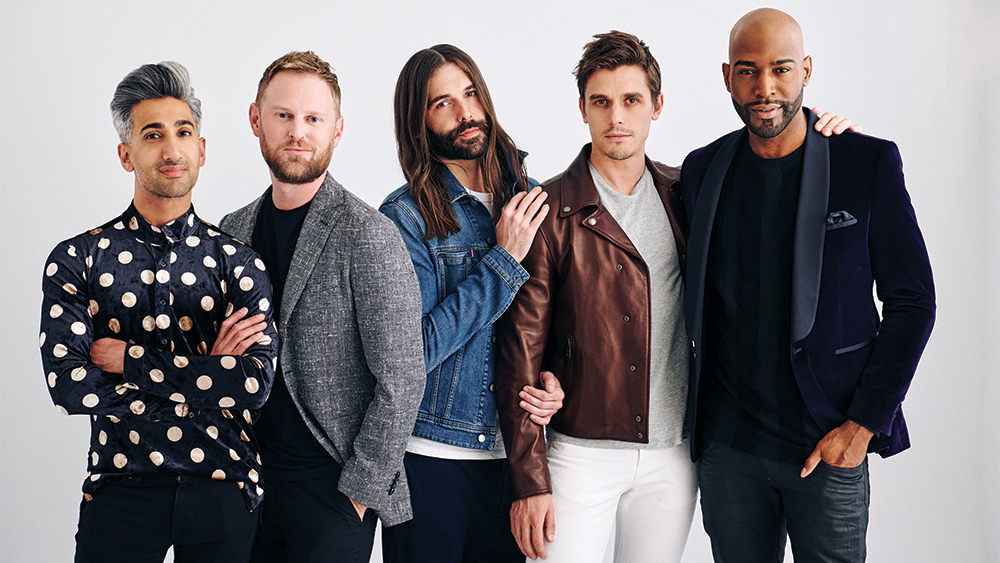With the Fab Fives’ long-awaited return, Netflix users tuck in to Queer Eye’s third season to watch both heart-breaking and heart-warming conversations, mesmerising physical, mental and architectural transformations with an overwhelming sense of fabulousity. Despite being a pioneer for representation, the show was criticised for issues including repetitive choices of subjects as well as structure and its core materialism. Has Season 3 managed to overcome these faults? To quote Jonathan Van Ness: Yasss Queen!
A reboot of the popular early 2000s makeover show Queer Eye For The Straight Guy, Netflix’s 2018 smash hit was instantly praised for it’s cast of unapologetically gay and diverse hosts Jonathan, Antoni, Karamo, Bobby and Tan (joined in Season 3 by Bruley, a beautiful French Bulldog). However, where some viewers felt it stumbled was its not so diverse crop of makeover subjects.
Of its first eight episodes, seven were focused on straight men, albeit of differing ethnicities. Whilst Season 2 featured their first trans man and first woman – God Bless Mama Tammye -, six of its eight episodes were, once again, focused on straight men. The traditional structure of Fab Five arriving, fixing the straight man’s toxic masculinity and then strutting away to their loft worked for a while but with some hugely welcome tweaks the show has reached new heights.
As expected, Season 3 features straight men as the majority (5 out of 8 episodes) but where it succeeds is the variance of situation. For starters, the show has shifted geographically from Atlanta to Kansas City which immediately provides its own experiences and issues.
On top of this, the show mixes it up with interesting subjects with even the straight men struggling with toxic masculinity thoughts being in more diverse situations. Highlights include: Shorty and Little (black sisters who co-own a BBQ fast food place), Jess (a black lesbian woman who has struggled with her sense of family after coming out to a negative adoptive family), Joey (a divorced summer camp guidance councillor suffering ‘Peter Pan’ syndrome who needs to grow up to provide for his son) and Rob (a heterosexual widower moving house).
From the shows conception it has been based around how the five experts (Culture, Cuisine, Fashion, Grooming and Design) work to improve different aspects of the subject’s life however this created a very tight structure that felt repetitive. Season 3 breaks down these boundaries with the hosts venturing into each other’s areas of expertise to create a fairer mix of screen time and a less predictable episode.
This season sees Jonathan take a bit of a back seat as the other four hosts come into the fray is a much more balanced season. In the past Karamo would organize any experience for the participant that wasn’t directly within one of the five categories. This time around the audience sees hosts like Bobby and Antoni partaking in gym sessions or Tan and Jonathan going clothes shopping.
One of the season’s highlights was when Bobby takes Jess to learn about her genealogy and be reunited with her long-estranged sister. These scenes are especially poignant due to both Bobby and Jess having been alienated from their adoptive families at a young age due to their sexuality. If you want tears, this episode will give you it.
Another highlight being when Karamo takes Jody to meet a group of extremely diverse women to discuss self-love and worth. It’s an honestly stunning moment.
The one issue this season hasn’t improved much on is that of the blatant reliance on capitalism and materialism. Whilst Karamo is helping improve self confidence and removing the influence of toxic masculinity and Antoni is making food, the show continues to rely on Jonathan, Tan and Bobby to flash the cash and buy new clothes, new furniture and pay for haircuts. Every issue a man has seems to be fixed with $14 face cream, a daily affirmation, some avocados and a new living room. Whilst this lifestyle sounds pretty swell, it perpetuates a standard that not everyone can afford to maintain.
However, you can’t stay all that mad about it, this materialism buys – pun intended – into the millennial Instagram-fuelled mindset that is prevalent in 2019. Whilst on the adverse side, you do learn some affordable things from the show. Antoni teaches easy, budget friendly recipes. Karamo works to build your confidence from the inside out. At one point, Jonathan even teaches a participant a home remedy for dandruff. A spray bottle with half apple cider vinegar and half water. Sprayed on your scalp, left for a while and then washed out to remove the smell.
We’ve all dreamt about being more confident with a new wardrobe, the ability to cook well, a beautifully designed house and better hair. The reason why Queer Eye is so universally loved is because the Fab Five provide the wish fulfilment for a few chosen participants.
Everyday you hear about the new TV show fad on Netflix which makes some people understandably hesitant – no matter how many times you tell me I won’t watch 13 Reasons Why! However, Queer Eye is different. Everyone is telling you to watch it for a reason. It’s the perfect feel good show for any time of the week.
So, grab some avocado on toast, wear a French tuck and draft your ‘I need the Fab Five to Queer Eye my life’ tweets and enjoy the emotional rollercoaster that is Queer Eye Season 3. They’ll be back later this year with a 4-episode Japan based special so expect more content soon!

